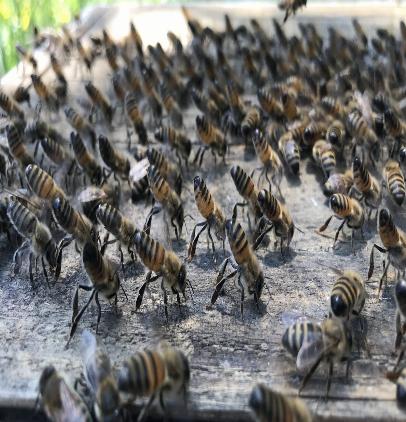Should you have encountered or suspect a bee infestation in or near your property, you may have several inquiries and apprehensions regarding the nature of the situation, your newly acquired guests, and the most efficient course of action. In the following section of our bee removal FAQ, we address some of the most frequently asked inquiries regarding bee removal.
What is the distinction between a flock, colony, and beehive?
Although these terms are frequently applied interchangeably, they do possess a substantial distinction. It is critical to comprehend this distinction in order to implement efficient bee management. Before anything else, it is important to note that these terms denote the various phases and facets of a bee colony’s life cycle.
A bee swarm is an ephemeral assemblage of bees, comprising a queen and honey worker bees, which depart from the colony’s progenitor in pursuit of an alternative habitat. Swarms may be observed congregating on fences, trees, receptacles, or shrubs. Swarms exhibit a general disposition of submission and seldom engage in aggressive behavior unless provoked, owing to their lack of a nest to defend during their search for a new habitat. Swarming bees are the most trivial to eliminate.
- The physical structure within which the complete bee community resides is referred to as a “hive.”
- The term “colony” denotes a swarm of bees residing in a single hive. The queen, worker bees, and drones comprise it.
Could bees cause property damage?
Infestations of bees have the potential to cause extensive property damage, encompassing structural impairments as well as harm to wood, sheathing, and insulation. As the weight of the hive increases, the walls and roof may begin to expand or sag, resulting in the formation of fissures and leakage. Additionally, honey and wax from the hive can cause damage by penetrating the walls and ceilings. Additionally, damage can be caused by bees, such as carpenter bees, which bore cavities through timber. Notably, homeowner’s insurance rarely covers property damage caused by a bee infestation; therefore, it is advisable to address the issue as soon as possible.
What is the distinction between extermination and living bee removal?
Extermination and live bee eradication are two distinct methods for managing bee infestations. Extermination entails the removal of the hive and the destruction of the bees (often with pesticides). Conversely, live bee removal entails the secure extraction of the bees from the hive and their subsequent relocation to an area separate from structures and residences.
The eradication of live bees is regarded as a more humane and environmentally sustainable method due to its emphasis on bee population conservation.
Our area of expertise is live insect removal.
Should I endeavor to manually eliminate the bees?
The act of bee eradication carries with it an inherent peril, as it entails several substantial hazards. Attempting to remove bees on your own without the appropriate knowledge, skills, and equipment may result in stung incidents, property damage, and environmental harm. Always consult a professional for bee removal services.
Invasion of wasps into my home: why?
In their search for a new nesting site, bees take into account various criteria to ensure a secure and appropriate environment. Your residence may have fulfilled the necessary criteria. Cavities with sufficient space for comb construction and offspring rearing, proximity to food and water sources, and lingering odors from previous colonies or nests are a few factors that may attract bees to your residence.
How is safety maintained throughout the removal procedure?
We prioritize both our own and the homeowner’s safety. During the eradication process, we consistently utilize comprehensive protective equipment and implement techniques that reduce the likelihood of aggressive behavior.
What happens to the bees following their removal?
We have not completed the removal of live bees until they have been relocated to a more suitable and secure environment away from human activity. There are instances when beekeepers are required to furnish a new habitat for the bees.
May wasps return following their removal?
Extremely high probabilities exist that bees will establish a new colony or return to the same area if the colony is not completely eradicated. We, being experts in live bee removal, are equipped with the necessary knowledge and machinery to guarantee a comprehensive expulsion. In addition, we provide recommendations and implement preventative measures against reinfestation.
This FAQ should have been able to provide answers to some of your most pressing concerns concerning bee removal. Please contact us immediately for additional information and assistance.
